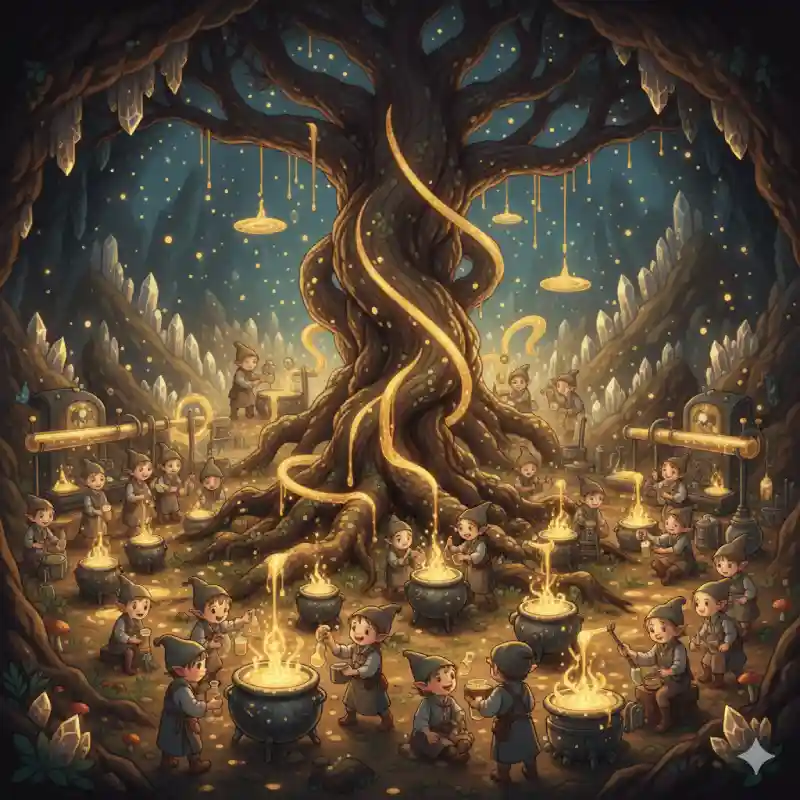In a ground breaking study that has since gone viral, scientists have discovered that trees do indeed grow gold and act as treasure maps for what lies beneath the surface
Gold does grow on trees, not in the form of coins or bars hanging around the branches like fruit, but in glittering microscopic specks. A team in Finland recently found actual gold nanoparticles hiding inside the needles of Norway spruce trees, yes, inside the plant tissue, not just dusting the surface.
The discovery adds a fresh twist to a decades-old mystery that’s fascinated both scientists and prospectors: how plants living above gold deposits end up with traces of the metal in their leaves. This new research suggests that the real alchemists here might be microbes quietly turning dissolved gold in the soil into solid particles within the plant itself.
So, while you won’t be panning for treasure in a pine forest anytime soon, trees may be whispering geological secrets about what’s buried under the ground.
Nature’s Little Alchemists

The study, conducted by the University of Oulu and the Geological Survey of Finland, examined spruce trees growing in Lapland, an area known for its gold-bearing rocks. Out of 138 samples from 23 trees, gold nanoparticles were detected in the needles of four, suggesting that the process isn’t universal but highly localised.
What’s fascinating is how the researchers linked the phenomenon to bacteria living inside the needles, called endophytes. These endophytes convert dissolved gold ions into metallic nanoparticles by way of a process commonly referred to as biomineralization. In simpler terms, the tree absorbs water containing trace gold, and the microbes chemically “fix” that gold into solid particles.
Under a microscope, the gold shows up as glittering flecks embedded deep within the needle tissue, far beyond what mere surface contamination could explain.
This isn’t exactly a brand-new revelation. More than a decade ago, a team in Australia found faint traces of gold inside eucalyptus leaves, which set off a mini media frenzy about “golden trees.” The trouble was, no one could say for sure if that gold really belonged inside the plant or was just dust that hitched a ride on the surface.
The new Finnish study clears that up once and for all. Using high-resolution imaging, scientists confirmed that the gold sits deep within the plant tissue, proof that it’s being absorbed and transformed, not just sticking there by accident. What’s even wilder is how microbes seem to be doing the heavy lifting, quietly processing dissolved gold and locking it into tiny metallic grains.
It’s not lab trickery this time, it’s nature’s own version of nanotechnology playing out in a forest.
Biogeochemical Prospecting

Still, before anyone dreams of “forest mining,” there’s a bit of a reality check. The amount of gold found in these needles is vanishingly small, billions of times less than what would make a gram. Economically, it’s useless. Scientifically, though, it’s a pretty big deal. The discovery could help improve mineral exploration techniques, which would then allow geologists to identify buried gold deposits by studying nearby vegetation instead of drilling blindly or going through a much lengthier and conventional process of locating gold deposits.
It also deepens our understanding of how biological systems interact with metals, possibly even offering clues for bioengineering eco-friendly ways to extract valuable elements in the future. These microbes could quite possibly hold the key to sustainable resource detection, bridging biology and geology in the most unexpected of ways.
In India, in particular, the idea of using plants to hunt for minerals could essentially rewrite how we conduct gold explorations. Mining has always been a two-sided sword here, with torn-up hillsides, displaced villages, and endless environmental issues. But imagine if scientists could skip the drilling altogether and just read the land through its own vegetation. A patch of leaves might whisper where gold or copper sleeps underground. This method, called biogeochemical prospecting, could be especially useful in mineral belts across Jharkhand or Karnataka. It’s cheaper, quieter, and doesn’t scar the earth.
As India talks about cleaner, more Aatmanirbhar ways to find and process critical resources, this plant-based approach fits right in. Maybe one day, satellite data and forest chemistry together will map out where the next big discovery lies, with no explosions, no digging, just the quiet intelligence of nature doing the work.
What Lies Beneath
In the end, the Finnish study doesn’t prove the old saying “money doesn’t grow on trees” false, but it does make the concept more interesting. Trees might not be a source of instant wealth unless you’re a red sandalwood smuggler, but they could become nature’s storytellers, hinting at what lies beneath our feet.
While scientists have pointed out that the bacteria around tree roots are quietly running microscopic gold-making factories, this could just be the tip of the iceberg in terms of the extraordinary chemistry that plants are capable of. The next time you see sunlight glinting through a Pine forest, remember: somewhere in those needles, a microscopic speck of gold might actually be the source of that glint.
In case you missed:
- AI Uncovers Thousands of Potential Psychedelic Compounds!
- China’s just created an AI-powered Inspector for Nuclear Disarmament!
- India’s first Aatmanirbhar Chip Fab: TATA leads the way!
- Could Contact Lenses be the Key to Fully Wearable BCIs?
- The Sodium-Ion Breakthrough That Could Unplug Lithium’s Reign
- Having two left thumbs may no longer be a bad thing
- China launches world’s first AI-powered underwater data centre!
- Scientists establish two-way Lucid Dream communication!
- Humans Just Achieved Teleportation? Clickbait vs. Facts
- One Chip to Rule Them All: The 6G Chip at 100 Gbps!










